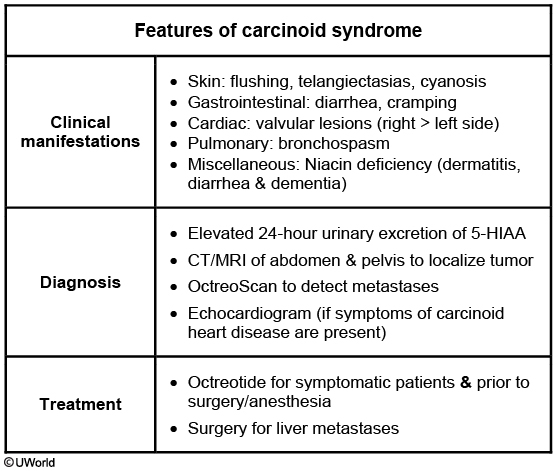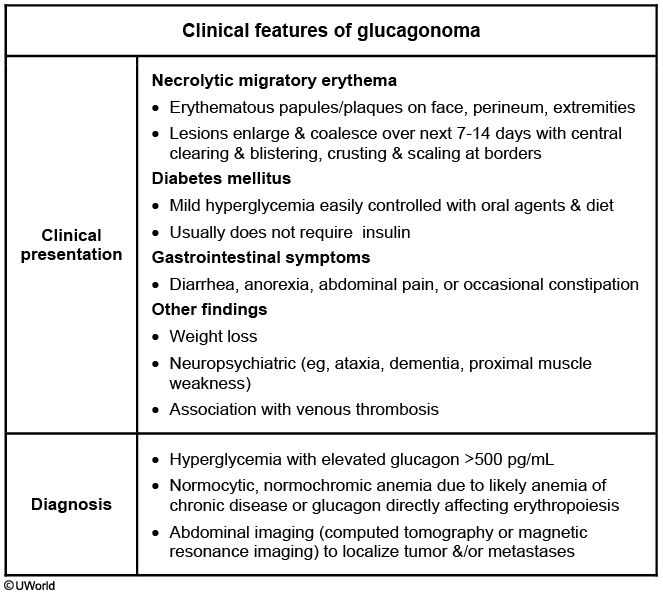19 Neuroendocrine Tumors
Overview
Location
Cancer
Thyroid
Medullary
Pancreas
Insulinoma, VIPoma, glucagonoma, gastrinoma
Lungs
Carcinoid, SCLC
Adrenal
Pheochromocytoma
PNS
Schwannoma, Neurolastoma
Skin
Merkel
Inherited
MEN1, 2, NF1, TS, VHL
Carcinoid Tumors
Carcinoid tumors are the most common tumors of neuroendocrine origin, and are derived from primitive stem cells in the gut wall.
Locations of carcinoid tumors include:
Appendix (most common)
Bronchopulmonary tree
Ileum
Rectum
Most carcinoid tumors occur in adults and are very rare in children.
Patients with a carcinoid tumor may be asymptomatic or have intermittent abdominal pain. Based on the location of the tumor, patients may exhibit carcinoid syndrome, which includes:
Flushing (early and frequent symptom, in 94% of patients)
Diarrhea
Bronchoconstriction
Tricuspid/pulmonary valvular disease
Symptoms

Carcinoid syndrome only occurs if a GI tumor has metastasized to the liver, or if the primary tumor exists outside of the GI system (i.e. locations that don't drain into the portal system). Carcinoid syndrome is primarily associated with tumors that metastasize from a primary location in the midgut.
The symptoms of carcinoid syndrome are caused by secretion of serotonin by the tumor.
In patients with carcinoid syndrome, wheezing and a right-sided heart murmur may be seen on cardiopulmonary exam.
niacin <- Tryptophan -> serotonin
Due to the shunting of tryptophan to serotonin formation and away from nicotinic acid metabolism, patients may develop symptoms of pellagra, or niacin deficiency. Symptoms include dermatitis, glossitis, and angular stomatitis.
Diagnosis
Diagnosis of carcinoid tumor requires a detailed history and physical exam. Characteristic biomarkers that are elevated include:
Urine 5-hydroxyindolacetic acid (5-HIAA): best screening method
Serum serotonin
The most common techniques for tumor localization are CT scans of the liver, thorax, and abdomen and indium-labeled octreotide scintigraphy. Acceptable alternatives include contrast-enhanced MRI, which is particularly good at identifying liver metastases.
Complications of carcinoid tumor may include:
Carcinoid syndrome (flushing, wheezing, diarrhea)
Carcinoid crisis (severe episode of flushing, hypotension, bronchospasm)
Bowel obstruction
Carcinoid heart disease (in particular tricuspid insufficiency, pulmonic stenosis: TIPS)
Metastasis
Recurrence
Treatment
For tumors that are not metastatic, resection of the primary tumor is curative.
Pharmacologic therapy with octreotide (a somatostatin analogue) is useful for pre-operative symptom management, and in patients with tumors that are non-operable.
In addition to octreotide, metastatic disease may be treated with IFN-alpha and chemoembolization of the hepatic artery.
Patients with completely resected localized disease have an excellent prognosis. Poorer prognosis is associated with metastases, tumors > 2 cm in size, and patients with positive lymph nodes.
VIPoma
A VIPoma is a rare neuroendocrine tumor that primarily appears within the pancreas and secretes vasoactive intestinal peptide (VIP). VIP causes excess fluid secretion within the intestinal lumen, resulting in severe diarrhea.
The peak incidence occurs within the fifth decade of life and has an association with multiple endocrine neoplasia (MEN) type 1.
The classic presentation is severe watery diarrhea despite not eating. Patients may also present with facial flushing, abdominal pain, and muscle cramps secondary to potassium loss.
VIPomas may eventually result in severe dehydration, acute kidney injury, and heart arrhythmias.
A diagnosis of VIPoma can be made in the presence of unexplained high volume diarrhea along with a serum VIP level exceeding 75 pg/mL.
Other helpful laboratory tests in management include measuring serum potassium (will be low due to the diarrhea) and renal function (BUN/Cr elevated due to dehydration from diarrhea).
Helical-contrast CT is the best imaging modality in localizing VIPomas.
The best initial treatment of a VIPoma is replacement of fluid loss and correction of electrolyte abnormalities.
Somatostatin analogues such as octreotide and lanreotide are first-line in treating VIPomas. Both of these medications inhibit hormone release.
Patients refractory to somatostatin analogues should have glucocorticoids added to their treatment regimen.
Glucagonoma

A glucagonoma is a rare neuroendocrine tumor of the pancreas, which is characterized by glucagon overproduction, diabetes mellitus, and necrolytic migratory erythema (NME).
The exact etiology of glucagonomas is still unknown, but there is an association with multiple endocrine neoplasia (MEN) type 1.
Patients classically present with necrolytic migratory erythema (most common), weight loss (thin habitus), diabetes mellitus, cheilitis, psychiatric problems, and deep venous thrombosis (DVT).
Necrolytic migratory erythema (NME) typically occurs in high friction areas such as the hands, feet, legs, buttock, and perineum. Skin lesions begin as erythematous plaques, which enlarge and coalesce over a period of 7-14 days. As the lesions begin to heal, central clearing occurs, and they become indurated and bronze-colored in the center, with blistering and scaling at the borders.
A glucagonoma may result in secondary skin infections, scarring, diabetes, deep vein thrombosis, and pulmonary embolism.
The best diagnostic test for glucagonoma is a serum glucagon level (>500 pg/mL is highly suggestive, > 1000 pg/mL is diagnostic).
Necrolytic migratory erythema(NME) is the most common physical exam finding in patients with a glucagonoma. Since DVTs can be a problem in these patients, it is good to make sure they do not have calf pain with a dorsiflexed foot (Homan’s sign).
Contrast CT and MRI are the best imaging modalities in localizing tumor locations.
If the patient does not present with metastasis, then surgical resection is the treatment of choice as it can offer a complete cure. When metastatic disease is present, somatostatin analogs such as octreotide are first-line, which inhibit hormone production.
Gastrinoma
Zollinger-Ellison syndrome (ZES) also known as a gastrinoma is a non-beta cell islet tumor of the pancreas, which secretes high amounts of gastrin, leading to maximal acid output within the stomach. This ultimately leads to the formation of multiple refractory ulcers.
The epidemiology of ZES is not completely understood, but most patients receive a diagnosis between the ages of 20 and 50 years old.
There is a high association with multiple endocrine neoplasia type 1 (MEN 1), which is an autosomal dominant predisposition for the development of pancreatic, pituitary, and parathyroid tumors.
Patients typically present with complaints of abdominal pain, diarrhea, and heartburn. Other symptoms include nausea, vomiting and weight loss.
ZES may result in complications such as gastric and intestinal ulcers, perforation, strictures, blood loss, and weight loss.
The best initial screening test is a fasting serum gastrin concentration (>1000 pg/mL is diagnostic).
Somatostatin receptor scintography (SRS) is the best imaging modality for localizing both primary and metastatic lesions in Zollinger-Ellison Syndrome.
Intestinal ulcers manifest similarly to those with sporadic peptic ulcer disease, with often solitary ulcers less than 1 cm in diameter. They can be found in the first part of the duodenum (75%), distal duodenum (14%), and in the jejunum (11%). Post-bulbar or jejunal ulcers are often pathognomic for Zollinger-Ellison syndrome.
The primary management of ZES is controlling the acid secretion with proton pump inhibitors (PPI). When PPIs are unable to control the acid secretion, somatostatin analogs such as octreotide are incorporated, which directly inhibit gastrin secretion.
Patients with ZES and without metastasis to the liver should undergo surgical resection as it improves symptoms and survival
Pheochromocytoma
Pheochromocytoma: A rare neuroendocrine tumor of adrenal medulla chromaffin cells that secretes catecholamines.
Remember the rule of 10s:
10% malignant
10% found extraadrenal
10% are bilateral and associated with Von Hippel-Lindau, Neurofibromatosis 1 and MEN (multiple endocrine neoplasia) IIa and IIb
10% in children
10% familial (although it's thought to be up to 25%!)
10% calcify
The classic presentation for a pheochromocytoma is episodic hypertension that is resistant to treatment.
Patients may also experience “paroxysms”, which can be remembered with the 5 P’s:
Pressure (hypertension)
Pain (headache)
Perspiration
Palpitations (tachycardia)
Pallor
Long-standing undiagnosed pheochromocytoma can cause a cardiomyopathy (catecholamine cardiomyopathy).
A suspected pheochromocytoma is first evaluated biochemically prior to performing imaging.
The best initial tests for suspected pheochromocytoma are either:
24 hour urine test for catecholamines and metanephrines
Plasma metanephrines
If an initial biochemical test is suggestive of a pheochromocytoma, MRI or CT of the abdomen and pelvis is performed to localize the pheochromocytoma.
If the initial CT or MRI does not show a pheochromocytoma and there is still a high index of suspicion, iodine-123 (123-I) metaiodobenzylguanidine (MIBG) scintigraphy can be performed to detect previously undetectable adrenal tumors and extra-adrenal metastases.
Note: MIBG is structurally similar to norepinephrine and is taken up by adrenergic tissue. Thus, it is also used to localize neuroblastoma in children.
Pheocrisis
Complications: A "Pheo Crisis" is rare, but is the most feared complication in a patient with a pheochromocytoma; mortality rates approach 85%. It results in an adrenergic hypertensive crisis leading to multiple system organ failure.
Pheo Crisis can be induced by:
Anesthesia induction agents
Drugs (corticosteroids, metoclopramide, morphine, glucagon, chemotherapeutic drugs, sympathomimetics, and TCAs)
Emotional stress
IV urographic contrast
The treatment approach to a pheochromocytoma is accomplished with the following, in this order:
Irreversible α-blockade (phenoxybenzamine)
β-blockade*
Surgical resection
*A β-blocker may be added for rate control AFTER an α-blockade is established. (If used before the alpha blockade, β-blockade can lead to unopposed α-stimulation from catecholamines, causing a hypertensive crisis).
An alpha blockade prevents catecholamine surge during surgical resection of the tumor, which would be dangerous for the patient under anesthesia.
Medical management of hypertension is achieved with an irreversible, non-competitive, non-selective α-blocker such as phenoxybenzamine. Prazosin and terazosin may also be used with similar effect.
Note: Do not confuse phenoxybenzamine (irreversible α-blocker) with phentolamine (reversible α-blocker).
Malignant
There is currently no way to establish the diagnosis of malignancy in pheochromocytoma based on histopathologic evaluation (A). However, there are tumor characteristics that are associated with higher risk (e.g., larger size, extra-adrenal. location, certain genetic mutations, and a high tumor proliferative index). Malignancy is determined by the development of metastatic disease, defined by a recurrence in an area that normally does not have any chromaffin tissue (lymph nodes or a distant site such as the liver or lungs). MIBG scanning (B) can be useful to identify metastatic disease, but positivity of the primary tumor on MIBG does not determine whether it is malignant. Biomolecular markers (D) can differentiate a functional tumor from nonfunctional, but is unable to rule out malignancy. Similarly, intractable hypertension (E) is not a characteristic of malignancy.
Association
Pheochromocytoma is associated with neurofibromatosis-1 which may present with skin neurofi bromas (rubberlike discolored skin lesions) and cataracts.
Paragangliomas arise from extra-adrenal chromaffin tissue, with the most common location being in the abdomen (organ of Zuckerkandl). They are essentially identical on a cellular level to intra-adrenal pheochromocytomas. However, they are more likely to have a hereditary basis (30–50% of cases) and to be malignant (15–35%). The diagnosis is made by biochemical analysis followed by imaging localization. It is particularly important to consider a whole body functional scan due to the higher propensity for multifocal and metastatic disease.
Paraneoplastic Syndrome
This paraneoplastic syndrome, termed polycythemia vera, is classically associated with pheochromocytoma, renal cell carcinoma, hepatocellular carcinoma, and hemangioblastoma.
Last updated
Was this helpful?